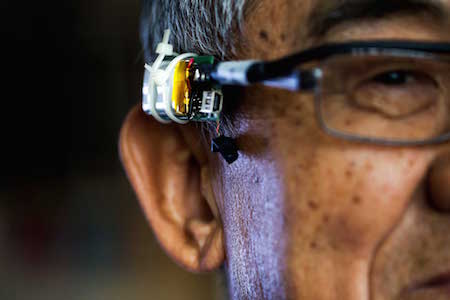Science Fiction
Dictionary
A B C D E F G H I J K L M N O P Q R S T U V W X Y Z
VAuth Voice Security Wearable From University of Michigan

The University of Michigan is working on a wearable device to improve the security of our voice-activated and voice-commanded electronics.
(University of Michigan VAuth)
Talking to electronics has become a popular—even essential—way to command them. In this era of the internet of things, voice assistants connect people to their mobile devices, homes and vehicles. Through spoken interactions, we place calls, send text messages, check email, get travel directions, control appliances, and even access bank accounts. Barclays bank, for example, recently began using a technology that uses voice to verify the identity of call-in center customers.But sound is what researchers call an "open channel" that can be easily spoofed by mediocre impersonators and sophisticated hackers alike.
"Increasingly, voice is being used as a security feature but it actually has huge holes in it," said Kang Shin, the Kevin and Nancy O'Connor Professor of Computer Science and professor of electrical engineering and computer science at U-M. "If a system is using only your voice signature, it can be very dangerous. We believe you have to have a second channel to authenticate the owner of the voice."
The solution that Shin and colleagues developed is called VAuth (pronounced vee-auth), and it's a wearable device that can take the form of a necklace, ear buds or a small attachment to eyeglasses. VAuth continuously registers speech-induced vibrations on the user's body and pairs them with the sound of that person's voice to create a unique and secure signature.
The process of speaking creates vibrations that can be detected on the skin of a person's face, throat or chest. The system works by leveraging the instantaneous consistency between signals from the accelerometer in the wearable security token and the microphone in the electronic device. You can only use voice authentication with your device when you're wearing the security token.
The team has built a prototype using an off-the-shelf accelerometer, which measures motion, and a Bluetooth transmitter, which sends the vibration signal to the microphone in the user's device. They've also developed matching algorithms and software for Google Now.
"VAuth is the first serious attempt to secure this service, ensuring that your voice assistant will only listen to your commands instead of others," Shin said. "It delivers physical security, which is difficult to compromise even by sophisticated attackers. Only with this guarantee can the voice assistant be trusted as personal and secure, especially in scenarios such as banking and home safety."

(VAuth voice authentication)
As Technovelgy readers know, science fiction authors are thinking ahead. Sometimes, they imagine more secure solutions - but sometimes they imagine ways around security measures. In this case, I was thinking of the voice-changing bowtie from Case Closed (Detective Conan). by Gosho Aoyama.

(Voice-changing tie)
Read more details at Wearables to boost security of voice-based log-in.
Scroll down for more stories in the same category. (Story submitted 11/2/2017)
Follow this kind of news @Technovelgy.| Email | RSS | Blog It | Stumble | del.icio.us | Digg | Reddit |
Would
you like to contribute a story tip?
It's easy:
Get the URL of the story, and the related sf author, and add
it here.
Comment/Join discussion ( 0 )
Related News Stories - (" Various ")
VAuth Voice Security Wearable From University of Michigan
'Siri, I gave you a voice command...' 'Yes, but do I know you?'
Technovelgy (that's tech-novel-gee!) is devoted to the creative science inventions and ideas of sf authors. Look for the Invention Category that interests you, the Glossary, the Invention Timeline, or see what's New.
Science Fiction
Timeline
1600-1899
1900-1939
1940's 1950's
1960's 1970's
1980's 1990's
2000's 2010's
Current News
Golf Ball Test Robot Wears Them Out
"The robot solemnly hit a ball against the wall, picked it up and teed it, hit it again, over and again...'
Boring Company Vegas Loop Like Asimov Said
'There was a wall ahead... It was riddled with holes that were the mouths of tunnels.'
Rigid Metallic Clothing From Science Fiction To You
'...support the interior human structure against Jupiter’s pull.'
Is The Seattle Ultrasonics C-200 A Heinlein Vibroblade?
'It ain't a vibroblade. It's steel. Messy.'
Roborock Saros Z70 Is A Robot Vacuum With An Arm
'Anything larger than a BB shot it picked up and placed in a tray...'
A Beautiful Visualization Of Compact Food
'The German chemists have discovered how to supply the needed elements in compact, undiluted form...'
Bone-Building Drug Evenity Approved
'Compounds devised by the biochemists for the rapid building of bone...'
Secret Kill Switch Found In Yutong Buses
'The car faltered as the external command came to brake...'
Inmotion Electric Unicycle In Combat
'It is about the size and shape of a kitchen stool, gyro-stabilized...'
Grok Scores Best In Psychological Tests
'Try to find out how he ticks...'
PaXini Supersensitive Robot Fingers
'My fingers are not that sensitive...'
Congress Considers Automatic Emergency Braking, One Hundred Years Too Late
'The greatest problem of all was the elimination of the human element of braking together with its inevitable time lag.'
The Desert Ship Sailed In Imagination
'Across the ancient sea floor a dozen tall, blue-sailed Martian sand ships floated, like blue smoke.'
The Zapata Air Scooter Would Be Great In A Science Fiction Story
'Betty's slapdash style.'
Thermostabilized Wet Meat Product (NASA Prototype)
There are no orbiting Michelin stars. Yet.
Could Crystal Batteries Generate Power For Centuries?
'Power could be compressed thus into an inch-square cube of what looked like blue-white ice'
